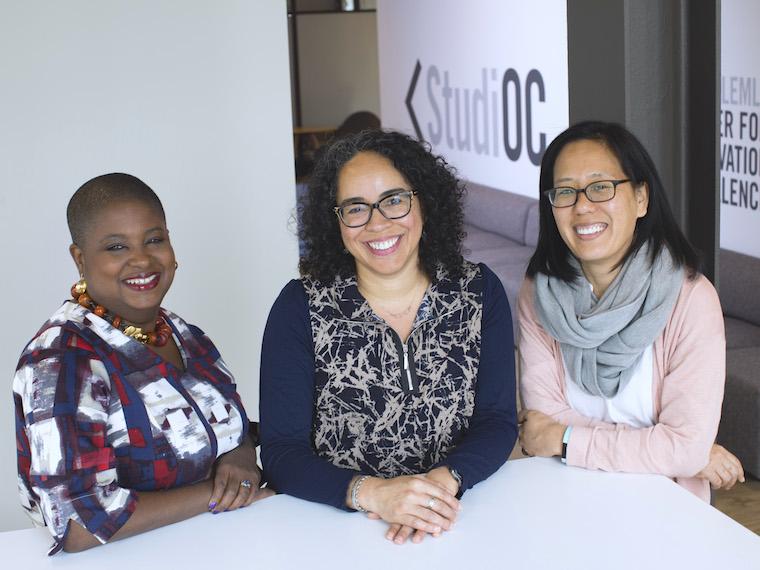Oberlin Center for Convergence (StudiOC)
Sanctuary Practices
Sanctuary is deeply embedded in the history of Oberlin.

Course instructors for this learning community are Meredith Gadsby, Gina Perez, and Shelley Lee.
Photo credit: Jennifer Manna
Sanctuary Practices: Race, Refuge, and Immigration in America
Offered Fall 2018
What are the connections between past and present practices of refuge and sanctuary both in Oberlin and nationally? By exploring this question from different disciplinary vantage points, this learning community introduces students to sanctuary as an issue at the center of debates around citizenship, immigration, public policy, diversity and inclusion that resonates as much today as it did in the 19th century. This learning community draws on literary and cultural analysis, history, and anthropological approaches to explore the meaning and practices of sanctuary in the United States.
- In This Here Place, We Flesh: Underground Railroad and Sanctuary Space, begins with the question of why the Underground Railroad is a persistent symbol of sanctuary in African American literature, art, and culture and provides students with the critical historical context of 19th-century sanctuary practices for fugitive slaves, the Underground Railroad and Oberlin’s distinct role in this history.
- Immigration in U.S. History surveys the history of immigration and migration in the United States, with particular consideration of the idea of America as a sanctuary, and how this idea intersects with constructions of race and citizenship.
- Sanctuary, Solidarity, and Latina/o/x Practices of Accompaniment locates contemporary sanctuary movements in a longer history of Central American sanctuary practices of the 1980s and Latina/o/x solidarity struggles in the 1960s to provide critical insight into the enduring practices and challenges of sanctuary, refuge and resistance in America.
Students enrolled in the learning community are required to attend additional events/sessions dedicated to visiting speakers, film screenings, local site visits, as well as a field trip to the Underground Railroad Museum in Cincinnati.
FYSP015 and either HIST/CAST 256 or CAST 210 required for enrollment in this learning community.
Instructors
Course instructors for this learning community are Associate Professor of Africana Studies Meredith Gadsby, Associate Professor of Comparative American Studies Gina Perez, and Professor of History and Comparative American Studies Shelley Lee.
Meredith Gadsby, instructor
FYSP 015 In This Here Place, We Flesh: Underground Railroad and Sanctuary Space
Meets Tuesday and Thursday,1:30 p.m., 4 credit hours, enrollment 15.
Required as part of the Sanctuary Practices: Race, Refuge, and Immigration in America StudiOC learning community.
Why is the Underground Railroad a persistent symbol of sanctuary in African American literature, art, and culture? Using the novel Beloved by Toni Morrison and the Toni Morrison Society Bench by Road project as the first stop, we will explore what sanctuary meant for enslaved people moving through Oberlin on the journey to freedom, for Africans who attended Oberlin since the 19th century, and present representations of the Underground Railroad in literature and art.
This course provides students with the critical historical context of 19th-century sanctuary practices for fugitive slaves, the Underground Railroad and Oberlin’s distinct role in this history.
Shelley Lee, instructor
HIST/CAST 256: Immigration in U.S. History
Meets Monday, Wednesday, and Friday, 1:30 p.m., 4 credit hours, enrollment 30.
Either this course or Sanctuary, Solidarity, and Latina/o/x Practices of Accompaniment required for Sanctuary Practices: Race, Refuge and Immigration in America”StudiOC Learning Community.
The course surveys the history of immigration and migration in the United States, with particular consideration of the idea of America as a sanctuary, and how this idea intersects with constructions of race and citizenship. It primarily covers the 19th to early 21st-centuries and addresses the international context of migration, migrants’ encounters with American society, policy, and significance of immigration in American culture.
Students will gain an introduction to major developments in the history of U.S. immigration, historicize contemporary debates, and develop comparative understanding of experiences among Asians, blacks, Europeans, Latina/o/x.
Gina Perez, instructor
CAST 210 Sanctuary, Solidarity, and Latina/o/x Practices of Accompaniment
Meets Monday, Wednesday, and Friday, 11 a.m., 4 credit hours, enrollment 20.
Either this course or Immigration in U.S. History required for the Sanctuary Practices: Race, Refuge and Immigration in America StudiOC Learning Community.
What are the roots of today’s sanctuary movements? And how are these practices similar to solidarity movements, past and present? This course locates contemporary sanctuary movements in a longer history of Central American sanctuary practices of the 1980s and Latinx solidarity struggles in the 1960s.
By interrogating the meaning of sanctuary, solidarity and accompaniment and examining the conditions that enable Latina/o/x struggles to be linked with those of black, Native American, Muslim and queer activism, this course provides critical insight into the enduring practices and challenges of sanctuary, refuge, and resistance in America.